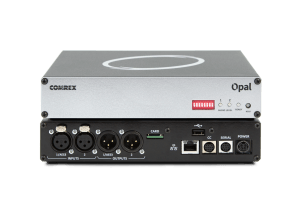Wondering how Opal will sound? Got questions about how installation will work?
Codec Answer Guy is here to answer some frequently asked questions about Opal, including installation and setup requirements.

Q: I hear the new Comrex Opal generating a lot of buzz. What is it?
A: We call Opal a “Web Audio Gateway”. It allows you to take “calls” from people on the Web. And it makes them sound like they’re in the studio.
Q: So it’s a telephone?
A: Not quite, although it can be compared to a studio telephone interface. It attaches to the Internet and provides pro-grade audio I/O to your studio. But telephones are not involved.
Q: So what does the caller use?
A: A computer or smartphone with a web browser and Internet service. Your guests can use Chrome, Firefox, Safari, Edge, or Opera to open Opal links.
Q: How does it sound?
A: Opal leverages an audio encoder called Opus, which is now built into web browsers. For techies, it offers 20Hz-20KHz response, with low delay both ways.
Q: How do I set up an Opal?
A: You’ll need to start with two things:
1. A public Static IP address for Opal
2. A registered Domain Name to that IP address in order to use security certificates
Q: Why do I need a Static IP?
A: All calls to Opal are incoming. Your callers will be sent a link to click in order to call Opal. If that link is always changing, it will cause issues. Also, Domain Names generally need a public static IP (as least as far as Opal is concerned). Also note the “public” part. The IP must be visible from the worldwide public Internet, not just your LAN.
Q: How do I get a Static IP?
A: You can lease a static IP from most Internet Service Providers. If you are part of a larger facility, your IT department can arrange to set one for you. You will need to enter the IP address, Gateway, Subnet mask and DNS address provided by your ISP or IT department into the Opal Toolbox interface (accessed via web page). This can be a complex topic in larger IT environments so talk to the pros about this.
Q: What’s a Domain Name?
A: It’s the familiar name you type into the web browser to go to a website, like google.com or yahoo.com. It makes up the basis of a URL, which is the full address used by your web browser. Example: Domain name = comrex.com URL= http://www.support.comrex.com/manuals
Q: Why do I need a domain name?
A: It’s a bit of a domino effect. The key to Opal is that it is simple for the user. To keep simplicity we use the caller’s web browser. In order to keep the web browsers from complaining, we need to provide SSL/TLS security. In order to have Opal provide this security, it needs a URL with a real Domain Name instead of an IP address (e.g. 74.94.151.151, like a codec would use).
Q: The security stuff sounds complicated. How does that work?
A: It’s completely transparent to you. As long as you’ve programmed your Domain Name into Opal (via the web-based Toolbox interface), it will retrieve security certificates automatically from a free service called “Let’s Encrypt”. The bonus to SSL/TLS security is that all calls are automatically encrypted before they hit the web.
Q: Can I use a Domain Name I already have a server on? Or a subdomain of an existing one?
A: Maybe. But Opal requires several ports that may be in use on your domain, including TCP 80 and 8082. Otherwise you can use a subdomain like opalcallers.mystudio.com.
Q: Where do I get a Domain Name if I don’t have one?
A: Do a web search on “Domain Names”. There are lots of low cost registrars out there. You’ll just need your Static IP to give them. Of course, your chosen name must be available, and you must renew it before it expires. There’s no need to get a “.com” domain, any suffix like .info or .ninja should work.
Unless you need it for other services, there’s no need to buy SSL certificates or any other security upgrades for your Domain Name from the registrar. Opal handles all that.
Opal works via sending and clicking links, and the Domain Name will be automatically put into the links, so it’s not that important that your name be simple or easy to remember.
Tip: Register both mystudio.com and www. mystudio.com to cover all your bases (most registrars will do this by default).
Another Tip: Make sure your domain is registered as a real DNS A Record pointing directly at your IP address, and not a domain “forwarding” service. The security certificates required will not work if your domain provider is forwarding or proxying traffic from their domain.
Last Tip: Dot.tk is a free domain provider that offers DNS A Records to names within their .tk domain. There are some limitations that may affect long-term use, but for testing they are recommended.
